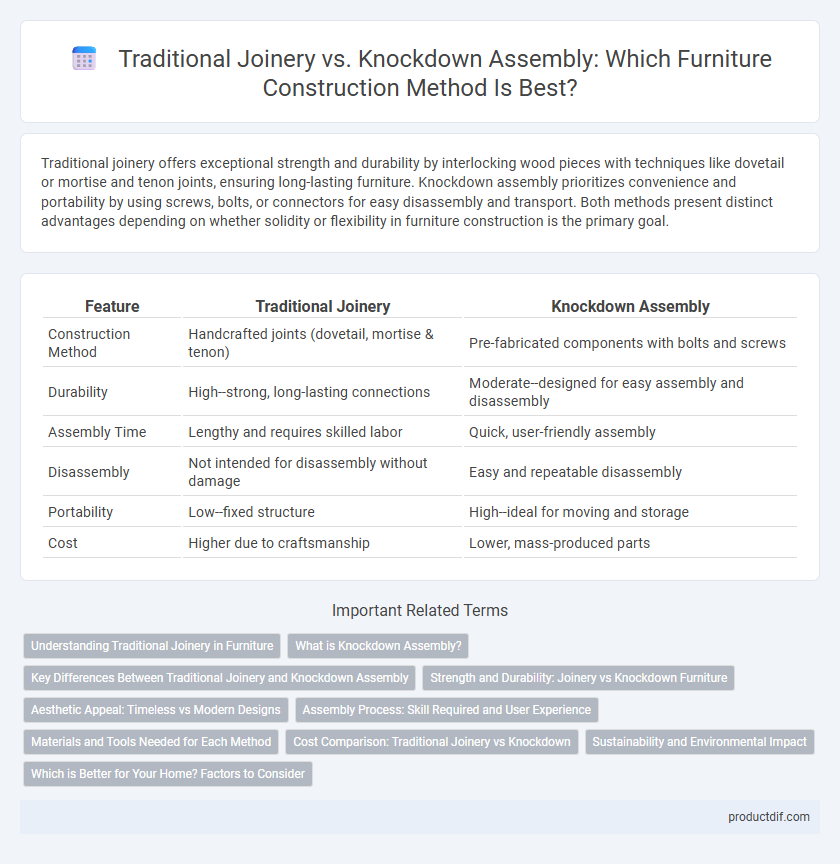Traditional joinery offers exceptional strength and durability by interlocking wood pieces with techniques like dovetail or mortise and tenon joints, ensuring long-lasting furniture. Knockdown assembly prioritizes convenience and portability by using screws, bolts, or connectors for easy disassembly and transport. Both methods present distinct advantages depending on whether solidity or flexibility in furniture construction is the primary goal.
Table of Comparison
| Feature | Traditional Joinery | Knockdown Assembly |
|---|---|---|
| Construction Method | Handcrafted joints (dovetail, mortise & tenon) | Pre-fabricated components with bolts and screws |
| Durability | High--strong, long-lasting connections | Moderate--designed for easy assembly and disassembly |
| Assembly Time | Lengthy and requires skilled labor | Quick, user-friendly assembly |
| Disassembly | Not intended for disassembly without damage | Easy and repeatable disassembly |
| Portability | Low--fixed structure | High--ideal for moving and storage |
| Cost | Higher due to craftsmanship | Lower, mass-produced parts |
Understanding Traditional Joinery in Furniture
Traditional joinery in furniture employs time-tested techniques such as dovetail, mortise-and-tenon, and tongue-and-groove joints, providing exceptional strength and durability without the use of metal fasteners. These methods enhance the structural integrity and longevity of wooden pieces, often resulting in handcrafted furniture with superior aesthetic appeal and craftsmanship. Mastery of traditional joinery requires precision and skill, ensuring tight-fitting joints that contribute to the overall stability and resilience of the furniture.
What is Knockdown Assembly?
Knockdown assembly refers to furniture designed for easy disassembly, allowing components to be quickly and efficiently put together or taken apart without specialized tools. This method uses standardized fittings like cam locks, bolts, and dowels to facilitate flat-pack shipping and convenience during transportation. Knockdown assembly is favored in modern furniture manufacturing for its cost-effectiveness, space-saving packaging, and user-friendly installation compared to traditional joinery techniques.
Key Differences Between Traditional Joinery and Knockdown Assembly
Traditional joinery relies on intricate techniques like dovetail, mortise and tenon, and dowel joints to create strong, durable furniture pieces that often require skilled craftsmanship and specialized tools. Knockdown assembly uses pre-engineered fittings such as cam locks, screws, and brackets to allow easy, tool-light disassembly and reassembly, ideal for flat-pack furniture and convenient transport. The main differences lie in durability, ease of assembly, and the necessity for craftsmanship versus mass production efficiency.
Strength and Durability: Joinery vs Knockdown Furniture
Traditional joinery techniques, such as dovetail and mortise-and-tenon, provide superior strength and durability by creating interlocking wood joints that resist stress and wear over time. Knockdown assembly relies on hardware like screws and cam locks, enabling easy disassembly but often compromising long-term stability under heavy use. Furniture crafted with traditional joinery maintains structural integrity for decades, making it ideal for heirloom-quality pieces requiring maximum resilience.
Aesthetic Appeal: Timeless vs Modern Designs
Traditional joinery showcases timeless craftsmanship with intricate hand-cut joints that enhance the natural beauty of hardwoods, offering a classic aesthetic appeal favored in heirloom and antique-style furniture. Knockdown assembly emphasizes sleek, modern designs with clean lines and minimal visible hardware, appealing to contemporary tastes and ease of transport. The choice between these methods influences the visual impact and style cohesion of furniture in residential and commercial interiors.
Assembly Process: Skill Required and User Experience
Traditional joinery demands advanced woodworking skills and precision to create strong, seamless joints, resulting in durable and aesthetically refined furniture. Knockdown assembly requires minimal technical expertise, offering a user-friendly, quick setup with pre-fabricated components that enhance convenience and portability. The assembly experience contrasts significantly, with traditional joinery emphasizing craftsmanship and permanence, while knockdown suits modern lifestyles prioritizing ease and flexibility.
Materials and Tools Needed for Each Method
Traditional joinery relies on hardwoods like oak, maple, and walnut, requiring precision tools such as chisels, hand saws, and mortise gauges to create durable, interlocking joints like dovetails and mortise-and-tenon. Knockdown assembly primarily uses engineered wood products including plywood and MDF, with hardware like cam locks, screws, and brackets, assembled using power drills and screwdrivers for quick, modular construction. Selecting materials and tools impacts furniture longevity, with traditional joinery favoring artisanal craftsmanship and knockdown assembly emphasizing ease of transport and cost-efficiency.
Cost Comparison: Traditional Joinery vs Knockdown
Traditional joinery typically involves higher labor costs due to skilled craftsmanship and longer assembly times, resulting in increased overall expense. Knockdown assembly offers cost savings with mass-produced components and simplified installation, reducing manufacturing and shipping expenses through flat-pack designs. Evaluating the cost-effectiveness depends on factors such as furniture durability, customization needs, and long-term maintenance.
Sustainability and Environmental Impact
Traditional joinery techniques, such as dovetail and mortise-and-tenon joints, enhance furniture durability and longevity, reducing the need for frequent replacements and thereby minimizing environmental waste. Knockdown assembly uses screws and metal fasteners allowing easier disassembly and transportation, which can lower carbon emissions during shipping and facilitate recycling or repurposing of components. Choosing furniture with sustainable joinery methods directly influences resource efficiency, carbon footprint reduction, and overall environmental sustainability in the furniture industry.
Which is Better for Your Home? Factors to Consider
Traditional joinery offers superior durability and aesthetic appeal due to precision craftsmanship, making it ideal for long-term investment furniture in homes seeking timeless elegance. Knockdown assembly provides convenience with easier transportation, flexible reassembly, and cost-effective solutions suitable for renters or those frequently relocating. Consider factors such as longevity, budget, ease of installation, and the desired furniture style when deciding the best option for your home.
Traditional Joinery vs Knockdown Assembly Infographic

 productdif.com
productdif.com